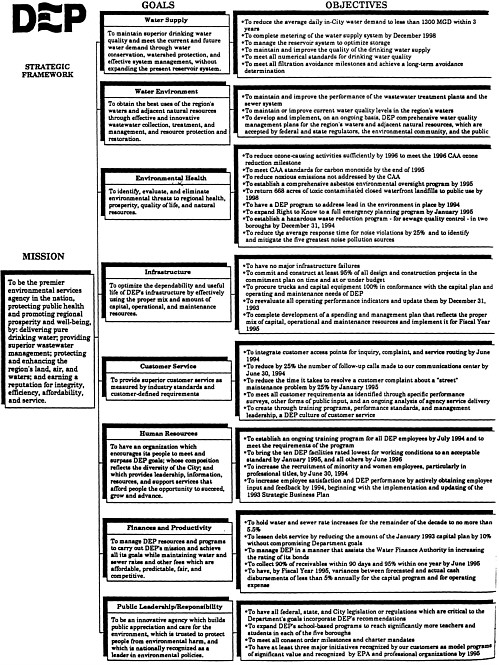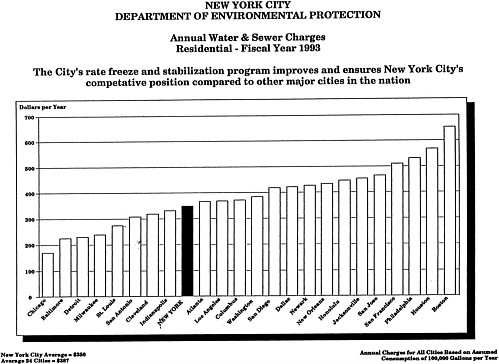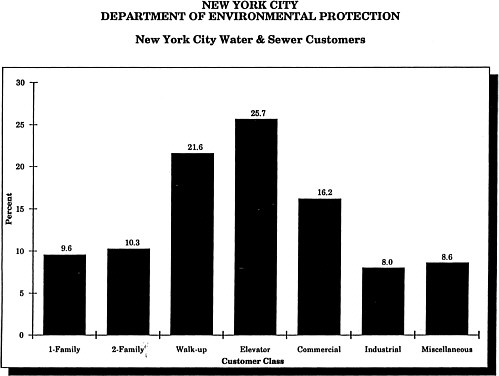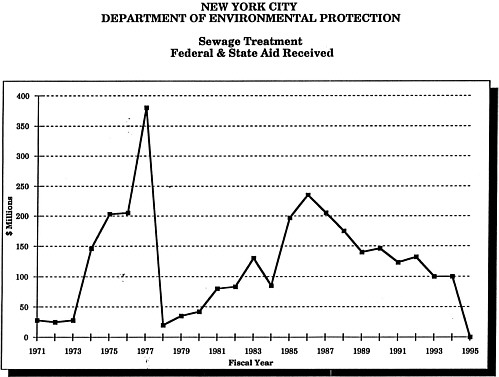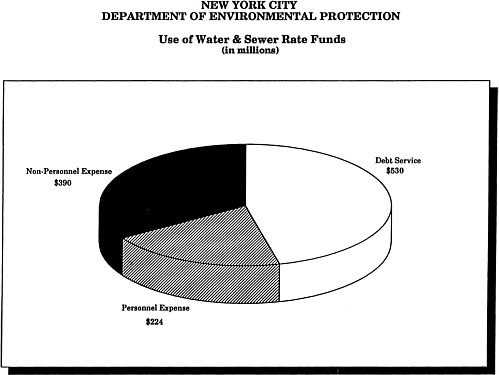NEW YORK CITY DEPARTMENT OF ENVIRONMENTAL PROTECTION
Strategic Business Plan
OVERVIEW AND INTRODUCTION
Over the last three years, the New York City Department of Environmental Protection has faced three interlocking challenges. First, to meet a critical series of environmental threats without being forced to spend billions of additional dollars on capital facilities. Second, to end the escalation of water and sewer rates and provide relief to ratepayers, especially those in the hardest hit affordable housing sector. Third, to improve day-to-day service delivery while dealing with significant resource and staffing constraints.
To meet these challenges, the Department has undertaken a series of major new initiatives including watershed protection, refocusing water policy on water conservation, comprehensive harbor wide planning, city-wide leak detection and water main flushing programs, an unprecedented program of capital construction, and a modernizing of its billing and customer service information systems, while aggressively amassing major cost savings.
Now, it is time to integrate and finalize these initiatives as future water system policy and, above all, to set priorities to insure these initiatives can be attained within the resource constraint of affordable water rates. This plan does so.
The measures in this plan combined with past savings make possible a two-year water and sewer rate freeze and a limit in rate growth for at least three years thereafter to an inflation-indexed cap, currently projected to be 5.5% annually. In addition this plan enables the City to propose individual payment caps and other rate relief measures for rate payers with high bills, including a rebate program for toilet retrofits.
This is not a typical strategic plan. First, it was put together by operating managers, not planners. Second, it was an exercise done in full partnership with the City's financial agencies. Third, it is action oriented. Fourth, and most crucially, it is resource driven. That is why the emphasis is not only on the strategic, but on the business component. It is a blueprint for future structural balance between DEP goals of premier service and affordable rates.
The features of the plan can be briefly summarized. The greatest threat to long term affordable rates is growth in capital program debt service. The biggest needs of the system are for better operating and maintenance programs, for pollution prevention and water conservation and for better response to customer service needs, all of which save money and reduce capital needs. Thus the plan is based on shifting resources to these programs
through lowering debt service (with a priority on measures that obtain the same capital construction for less money, i.e., by accelerating construction now to obtain low recession bids) and continuing to improve the productivity of existing programs.
The plan also formalizes DEP's commitment to continue to pursue productivity through collaborative strategies: internally through better management and partnership with the DEP workforce; inter-governmentally with other City agencies; externally with our stakeholders: customers, neighborhoods, housing groups, and the environmental, business and construction communities. Their assistance has been crucial to the many successful changes in DEP policies and programs over the last three years.
In closing, this plan needs to be seen as on on-going effort, a work in progress. The commitment to attaining both premier service and affordable rates through good business planning will remain a constant of DEP's future, but the details of the plan itself will continually evolve as they are refined in implementation, for a strategic business plan is only successful as a guide to successful action.
BACKGROUND
The New York City Department of Environmental Protection (DEP) is responsible for water supply, sewage collection and treatment, and overall environmental protection. Its history dates back to 1842, when water flowed for the first time from upstate reservoirs into New York City. Today, the agency is a complex enterprise with multiple bureaus, a large capital construction program, approximately 6,300 employees, and responsibilities that impact the health and well-being of every New York City resident.
Since the election of Mayor David N. Dinkins, and his subsequent appointment in 1990 of Albert F. Appleton as DEP Commissioner, the Department has gone through a major evolution, adding to its traditional engineering role new environmental and customer service capabilities, and a philosophy of integrated resource management. Strategies to focus on planning, avoiding and reducing costs, and protecting and better operating the water and sewer systems have been implemented, along with streamlining DEP's management structures.
In late 1992, DEP began to craft a strategic business plan to comprehensively address the long-term service needs and resource limits of the water system. That initial planning process has been completed and the resultant plan, which will structure and prioritize DEP's operations and resource use in the years ahead, is summarized in this document.
THE PROCESS
A successful strategic planning process requires:
-
A common understanding, internally and externally, of the principles guiding the agency.
-
A shared vision of DEP's ultimate goals and values.
-
An acceptance throughout DEP of the urgent need to implement the plan.
To establish this foundation, DEP conducted a series of workshops. Participants included selected DEP senior management personnel and representatives of key oversight agencies such as the New York City Office of Management and Budget, the New York City Office of Operations, and the Deputy Mayor's Office for Planning. The participation of the oversight agencies enabled DEP managers to integrate their views into broader City perspectives.
The accounting and consulting firm of Ernst & Young was engaged to assist in the research and analysis effort, to provide an external perspective, to design the
strategic planning process, to facilitate a series of senior management workshops, and to aid DEP in establishing the financial planning tools needed for the plan's successful implementation.
DEP MISSION STATEMENT
An organization's mission is the fundamental, unique purpose that sets it apart from other organizations and identifies its scope of operations.
Its three basic components are:
-
The central vision or purpose of the organization
-
The needs of the key parties who have a stake in the operations of the organization
-
The shared values or beliefs of the members of its members
DEP's mission is :
To be the premier environmental services agency in the nation, protecting public health and promoting regional prosperity and well-being by: delivering pure drinking water; providing superior wastewater management; protecting and enhancing the region's land, air, and waters; and earning a reputation for integrity, efficiency, affordability, and service.
DEP's mission presents a visionary view of long-term excellence.
DEP'S GOALS AND STRATEGIES
The strategic business plan includes eight goals which, when met, will represent achievement of DEP's mission. These goals, and some of the pivotal strategies to achieve them, are described in this section.
Water Supply
To maintain superior drinking water quality and meet the current and future water demand through water conservation, watershed protection, and effective system management, without expanding the present reservoir system.
New York City is known for the excellent quality of its drinking water. To maintain this reputation and to assure that its customers receive a dependable supply of pure drinking water, DEP must adopt cost-effective strategies to ensure adequate water supply, and maintain and improve drinking water quality. The two strategies key to accomplishing this are to:
-
Continue to refine and implement a long-term, cost-effective, comprehensive water conservation plan with a consequent commitment of resources, in partnership with all DEP customers
-
Aggressively implement DEP's watershed protection and filtration avoidance program
Both strategies are being successfully implemented.
Water Environment
To obtain the best uses of the region's waters and adjacent natural resources through effective and innovative wastewater collection, treatment, and management, and resource protection and restoration.
New York City has an excellent sewage collection and treatment system. However, to finish the clean-up of the City's harbors and estuaries, obtain the best use of our waterways, and to enhance the overall environmental quality of the region, DEP must take the lead in continuing to improve the quality of the region's waters and the operation of the wastewater treatment plants and the sewer system. Here the critical strategy is to:
-
Convert current water quality plans, consent orders, and State Pollution Discharge Elimination System (SPDES) requirements into comprehensive basin-wide water quality strategies
The largest single component of the capital budget is over four billion dollars in the next ten years for harbor-oriented water quality facilities. Comprehensive water quality planning emphasizing pollution prevention and natural resource protection could provide for significantly greater environmental improvement at costs significantly below currently planned expenditures. Completing such a plan and obtaining public agreement on it is the most important planning task DEP faces in the next several years.
Environmental Health
To identify, evaluate, and eliminate environmental threats to regional health, prosperity, qunlity of life, and natural resources.
DEP's responsibilities extend beyond operating the water and sewage systems to include protecting the residents of New York City and the region from environmental damage caused by air pollution, toxic waste, asbestos, lead, noise, natural resource destruction, and other sources of environmental harm.
DEP's environmental health responsibilities give the agency a unique ability to develop across-the-board approaches to environmental protection and service delivery. To fulfill its mandate in these areas, DEP 's key strategic initiatives are:
-
Monitor and implement regulatory programs to insure all federal air standards are met.
-
Identify and remediate or preserve threatened or degraded sites using current and available scientific risk assessment-based data.
-
Promote waste reduction and pollution prevention activities.
Initiatives currently underway include DEP's programs in pollution prevention, green communities, wetlands protection, coordinated environmental enforcement, and small business assistance.
Infrastructure
To optimize the dependability and useful life of DEP's infrastructure by effectively using the proper mix and amount of capital, operational, and maintenance resources.
DEP operates a large, complex and structurally intensive network of water supply and sewage collection and treatment systems that every day must successfully bring water into 810,000 buildings and then remove sewage from them. Here the crucial strategy is to:
-
Determine and implement a cost-effective preventive maintenance and repair strategy, including the analysis of capital/maintenance/service-delivery tradeoffs
This strategy will redirect DEP resources into maintenance and operational programs that will improve service reliability while reducing long-term costs. DEP has already implemented programs of systematic leak detection, catch basin cleaning and main flushing and valve maintenance.
Customer Service
To provide superior customer service as measured by industry standards and customer-defined requirements
DEP must strive to be a customer service organization with a sensitivity and responsiveness to customer needs that is unsurpassed. The agency must continually work towards improving day-to-day service, to quickly and effectively respond to inquiries and complaints, to process customer bills on a timely basis, and to make our processes more customer friendly. Here the main strategy is to:
-
Develop and adequately support modern management information systems for rapid information exchange within DEP and with the public
Above all, this means that DEP must meet its June 30, 1994, date for completing the installation of a modern Customer Information and Billing System, and hire and train the personnel needed to manage the program successfully. To date, this effort is on schedule.
Human Resources
To have an organization which encourages its people to meet and surpass our goals; whose composition reflects the diversity of the City; and which provides leadership, information, resources, and support services that afford people the opportunity to succeed, grow and advance.
DEP's employees are the keys to DEP's success and to achieving DEP's mission and goals. DEP must assure that all employees share values of integrity, efficiency, affordability, and service, and perceive DEP as a partner in the achievement of their work and career goals. DEP must ensure that its staff is well trained, that they have adequate working conditions, and that they are empowered to participate and contribute to DEP's success.
The key to attaining this objective is effective internal service delivery, as measured by DEP efforts to improve its facilities, communicate with its employees, and obtain for them the tools of their trade. DEP's customer service strategy must be internal as well as external, as reflected in all the strategies to pursue this goal:
-
Refine organizational responsibilities and each unit's role in achieving DEP's mission
-
Implement a program to address compensation issues in a manner that is fair and promotes productivity and performance
-
Provide a safe and secure workplace and environment
-
Create a comprehensive communication program throughout the organization which includes regularly scheduled strategic planning meetings and a horizontal and vertical transfer of information
-
Develop and implement intra- and inter-bureau training and rotation programs
-
Establish diversity as a criteria in recruitment, selection, and promotion, and develop and implement appropriate internship and apprentice programs
-
Develop a program to recognize, mentor, and appropriately train the “next generation of management”
Finances and Productivity
To manage DEP resources and programs to carry out DEP's mission and achieve all its goals while maintaining water and sewer rates and other fees which are affordable, predictable, fair, and competitive.
DEP must operate in a fiscally responsible manner that controls costs, enhances revenue collections, improves budgeting and forecasting, and maintains a balance between revenues and expenditures to maintain structural balance between affordable rates and having the resources needed to meet service and environmental goals. Here the key strategies are to:
-
Review operations regularly to identify and implement productivity and other cost-effective measures to keep rates affordable and predictable
-
Maximize revenue collection within the established rate structure
DEP, with the assistance of its financial oversights and the Water Authority staff, has now had two years of successful cost savings and has been able to implement a number of ongoing cost-saving measures. As a result the City has been able to propose a two-year water and sewer rate freeze and an ongoing inflation-linked rate cap thereafter, currently estimated at 5.5% annually, and a series of other rate relief and customer service enhancements.
Reliable revenue management is a key to future strategic business plan success. If DEP fails to collect the revenue due to it, paying customers will be unfairly penalized and future rates will whipsaw back and forth. Here again, successful implementation of the Customer Information and Billing System and new billing policies is crucial to successful water and sewer rate management.
Public Leadership/Responsibility
To be an innovative agency which builds public appreciation and care for the environment, which is trusted to protect people from environmental harm, and which is nationally recognized as a leader in environmental policies.
Implicit in DEP's mission to be the premier environmental services agency in the nation is the responsibility to provide infrastructure and environmental leadership at the local, state, and national levels. Earning this leadership position will enable DEP to favorably influence environmental legislation and to gain the public trust and support needed to meet its mandated responsibilities and to preserve and protect the environment of New York City and the region. The strategies central to achieving this goal are to:
-
Actively involve impacted communities and interests in formulating and implementing DEP programs and policies
-
Develop networks of legislative, business, and professional organizations, environmental and advocacy groups, and outside experts to help guide DEP policy and programs
Leadership in the nineties is a collaborative art. The distant bureaucrat, the all-knowing government technical expert are creatures of the past. Today the first task of public leadership is to forge consensus and partnership that mobilizes all the resources of the City, public and private, to make the decisions on which the future of the water system and the City's environment rest.
SUMMARY
DEP's strategies are supplemented by detailed implementation plans which specify the necessary tasks, timetables, and responsible DEP bureaus. Strategic planning will enable DEP to successfully meet the challenges that the future will bring. This initial plan is just the first step in an ongoing strategic business planning and implementation process that will guide DEP activities, facilitate communication within DEP and with the oversight agencies, improve employee and system performance, and enable DEP to fulfill its mission as the premier environmental services agency in the nation, providing unmatched service to the residents of New York City and its region at an affordable cost.
FINANCIAL DISCUSSION
In the 1990s, sustainable development has become a key goal of environmental policy. The financial equivalent of sustainable development is structural balance, long term balance between spending needs and available funds.
In 1985, NYC established the current financial structure of the water supply and wastewater treatment system. The self-funding and dedicated revenue features of the water and sewer system, if properly utilized, provided the City with a unique opportunity to rationalize water system finances. Instead the financial planning that did take place treated budgeting DEP no differently from any other city agency, which considered capital money more affordable. In consequence, without much notice water rates moved steadily up.
However, once past 1990, the steady growth of water and sewer rates turned into a major issue. First, the city was plunged into its worst recession in over a generation. As building owners and operators struggled with shrinking income, they found the continued double digit growth in water and sewer rates steadily harder to bear. Second, the water and sewer system budget was staggered by the costs of taking sludge out of the ocean within three and a half years, and the end of nearly all Federal funding for mandated Clean Water improvements. The result was a 30% increase in water and sewer rates between 1991 and 1993, and growing consumer outrage.
As DEP moved to reform the management of the water system, it became apparent that DEP had a unique financial dynamic. On the capital side, DEP was faced with major annual increases in debt service that were locked in for many years to come. Debt service was already taking over 40% of DEP's current revenue and was projected to exceed 70% within ten years. By contrast, on the personnel side $12 million, 1% of the water and sewer rates, funds 300 DEP employees, or 5% of DEP's headcount, thus requiring a significantly disproportionate service impact to obtain any reduction in water and sewer rates. It became clear that controlling debt service was the financial key to the long-term future of the water and sewer rates.
But debt service on the current capital program was only the beginning of that problem. DEP was, and is, threatened by a series of possible new mandated capital expenditures totaling well in excess of $10 billion, an amount that would more than double the current capital budget. The list of possible future mandates includes: filtering the Catskill-Delaware watershed; adding new sewage treatment capacity to stave off building moratoriums; Combined Sewer Overflow (CSO) control; nutrient removal from sewage; floatable trash control; and new water supply reservoirs and other potential
requirements. The financial challenge these future mandates pose to the goal of affordable water and sewer rates can be stated with stark clarity: New York City must meet its environmental and service needs through investing now in pollution prevention, water conservation and better infrastructure management and operation, or face enormous future additions to a capital budget that is already the principal force in driving up water and sewer rates.
The strategic initiatives DEP has adopted to address this choice have been described in the previous section. Financially, the plan relies on the following measures:
-
Control future debt service cost:
-
Avoid any new capital construction mandates by investing upfront in environmental protection and pollution prevention.
-
Lower the debt service cost of the current capital program:
-
where possible, continue to accelerate capital construction to take advantage of lower recession bids, a strategy that has saved over $300 million in bid prices in the last two and a half years;
-
streamline the administration of capital construction to lower costs to contractors;
-
refinance existing bond debt to lower future debt service cost, a process that in FY 1993 has produced $10.6 million in debt service savings;
-
increase the use of pay-as-you-go capital funding to approach utility industry norms;
-
obtain additional Federal and state funding for mandated capital programs, and improve utilization of the State Revolving Fund.
-
-
To the extent these measures are insufficient, consider reducing or stretching out less critical elements of the capital program, particularly in the period 1996 to 2000, when the construction of mandated facilities will peak and the City completes its investment in the Third Water Tunnel.
-
-
Reduce operating expenses wherever possible.
Here again, the unique nature of the DEP budget needs a targeted effort. Nearly half of the operating and maintenance (O&M) budget is for non-personnel costs, an area where cost savings opportunities are far more significant and have far less impact on DEP services than personnel reduction.
This targeting strategy has been successful. To date, the Department has identified over $25 million in permanent annual savings in the sludge program and other OTPS costs without any impact on service.
-
Continue productivity improvements.
The third major cost saving element in the DEP strategic business plan is continued improvement in DEP productivity. DEP has long been concerned with productivity. In recent years the department has: eliminated over 300 administrative positions; broad-banded many of its major titles; held its management staff to 5% of the agency total; doubled the number of daily meter readings per employee; exceeded the projected performance of its sludge dewatering plants by over 20%; instituted apprenticeship programs for street laboring forces; reduced the size of catch basin, leak detection and other repair crews by designing specialized equipment to perform many of their tasks; and streamlined the administration of the capital construction program. This effort is continuing with a series of new productivity programs planned for FY 1994.
Central to the Department's productivity success has been the constructive and on-going dialogue DEP has been able to have with its employees and the unions representing them. The department is a strong supporter of DEP's labor-management Quality of Work Life program. DEP intends to expand this current dialogue to include gainsharing and other mutual approaches to continuing productivity and improvement.
-
Affordable future rates require expenditures now in programs that will lower future costs. These programs include continuing the Department 's new investments in watershed protection, water conservation, upgrading customer information and billing systems and preventive maintenance of infrastructure.
Through these initiatives, DEP will move toward maximizing the productivity of all the resources for which it is responsible. Only by doing so can it provide the services necessary to meet its mission and goals within the income constraints that are necessary to keep rates constant for the next two years and limit their growth in the future.

























